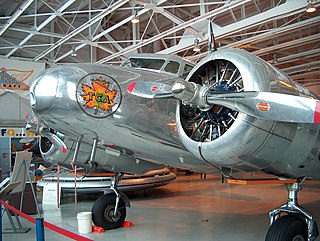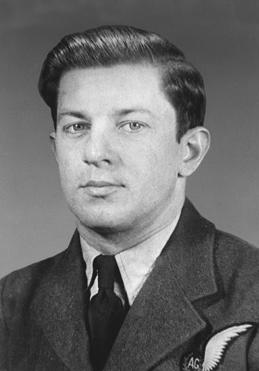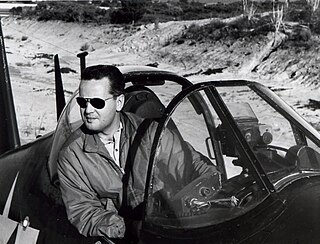
The Avro Lancaster is a British Second World War heavy bomber. It was designed and manufactured by Avro as a contemporary of the Handley Page Halifax, both bombers having been developed to the same specification, as well as the Short Stirling, all three aircraft being four-engined heavy bombers adopted by the Royal Air Force (RAF) during the same era.

The Avro Anson is a British twin-engine, multi-role aircraft built by the aircraft manufacturer Avro. Large numbers of the type served in a variety of roles for the Royal Air Force (RAF), Fleet Air Arm (FAA), Royal Canadian Air Force (RCAF), Royal Australian Air Force and numerous other air forces before, during, and after the Second World War.

The Handley Page Halifax is a British Royal Air Force (RAF) four-engined heavy bomber of the Second World War. It was developed by Handley Page to the same specification as the contemporary twin-engine Avro Manchester.

The Avro Canada CF-100 Canuck is a Canadian twinjet interceptor/fighter designed and produced by aircraft manufacturer Avro Canada. It has the distinction of being the only Canadian-designed fighter to enter mass production.

Trans-Canada Air Lines was a Canadian airline that operated as the country's flag carrier, with corporate headquarters in Montreal, Quebec. Its first president was Gordon Roy McGregor. Founded in 1937, it was renamed Air Canada in 1965.

No. 8 Group RAF was a Royal Air Force group which existed during the final year of the First World War and during the Second World War.

Squadron Leader Ian Willoughby Bazalgette was a Canadian-British pilot in the Royal Air Force during the Second World War. On 4 August 1944, while piloting an Avro Lancaster in a pathfinder role, Bazalgette and crew flew to Trossy St. Maximin in France to mark a V-1 flying bomb storage cave. Bazalgette's Lancaster was severely damaged by flak prior to arrival at the target and quickly set on fire. Despite the condition of his aircraft, Bazalgette continued to the target and accurately dropped his markers. After completing the task, Bazalgette ordered his crew to bail out, however, two members of the crew were wounded and unable to jump. Rather than saving himself and leaving the two men to die, Bazalgette attempted to land the burning plane to save his two crew members. Bazalgette landed the plane, but it exploded almost immediately upon alighting, killing all three airmen. For his actions, Bazalgette was posthumously awarded the Victoria Cross.

Andrew Charles Mynarski, VC was a Canadian airman and a recipient of the Victoria Cross, the highest award for bravery in the face of the enemy that can be awarded to British and Commonwealth forces. Mynarski was 27 years old and flew with No. 419 "Moose" Squadron, Royal Canadian Air Force during the Second World War when he died attempting to help rescue a trapped crew member. His Victoria Cross, which was awarded in 1946, was the last Victoria Cross received by any Canadian serviceman in the Second World War.

The Lincolnshire Aviation Heritage Centre is an aviation museum in East Kirkby, Lincolnshire, England. It was opened to the public in 1988 by Lincolnshire farmers Fred and Harold Panton, as a memorial to their older brother, Christopher Whitton Panton, who was killed on operations during the Second World War.
The Canadian Historical Aircraft Association is the former name of the Canadian Aviation Museum, a non-profit organization based in Windsor, Ontario which is committed to preserving aircraft which have significance to the history of Canadian aviation. They have a 1941 Boeing Stearman, a 1952 Mark IV Harvard, a 1946 Fairchild 24R "Argus" and two de Havilland Chipmunks available for special event fly-bys and donation flights.

The Bristol Fairchild Bolingbroke is a maritime patrol aircraft and trainer used by the Royal Canadian Air Force during the Second World War. Produced by Fairchild-Canada, it was a license-built version of the Bristol Blenheim Mk IV bomber.

Nanton is a town in southern Alberta, Canada. Nanton was named after Sir Augustus Meredith Nanton of Winnipeg (1860–1925) who directed firms which offered financing for farms and ranches throughout the west. It is located south of Calgary at the junction of Highway 2 and Highway 533.

Milo is a village in Vulcan County, Alberta, Canada. It is located on Highway 542, approximately 127 kilometres (79 mi) southeast of the City of Calgary and 72 kilometres (45 mi) east of the Town of High River. Milo is mainly an agricultural service community.

The Hangar Flight Museum, formerly known as the Aero Space Museum of Calgary, is a museum located south of Calgary International Airport in Calgary, Alberta, Canada.

No. 428 Squadron RCAF, also known as 428 Bomber Squadron, and 428 Ghost Squadron, was first a night bomber squadron of the Royal Canadian Air Force engaged in strategic bombing during World War II, based in Yorkshire. At the end of the war the squadron moved to Nova Scotia before being disbanded in September 1945. In 1954 the squadron was reformed as 428 All-Weather (Fighter) Squadron, before being again disbanded in 1961.

Air Commodore John Emilius Fauquier, was a Canadian aviator and Second World War Bomber Command leader. He commanded No. 405 Squadron RCAF and later No. 617 Squadron RAF over the course of the war. A bush pilot prior to the war, he joined the Royal Canadian Air Force as a flight instructor in 1939. He then joined 405 Squadron in 1941 and would fly operationally for the rest of the war, taking a drop in rank on one occasion to return to active command. During his three tours of operation he participated in Operation Hydra and dozens of other sorties over Europe.

Lynn Garrison is a Canadian pilot and political adviser. He was a Royal Canadian Air Force fighter pilot in the 403 City of Calgary Squadron, before holding jobs as a commercial pilot, film producer, director and mercenary. Garrison has also accumulated a substantial collection of classic aircraft, flying many of these as well as organising their restoration and preservation. He participated in the Nigerian Civil War as a mercenary, assisting the military of Biafra.
CFB Rivers was a Royal Canadian Air Force base located 5 km (3.1 mi) southwest of Rivers, Manitoba, Canada, at the junction of Manitoba Highway 25 and Manitoba Provincial Road 259.



























